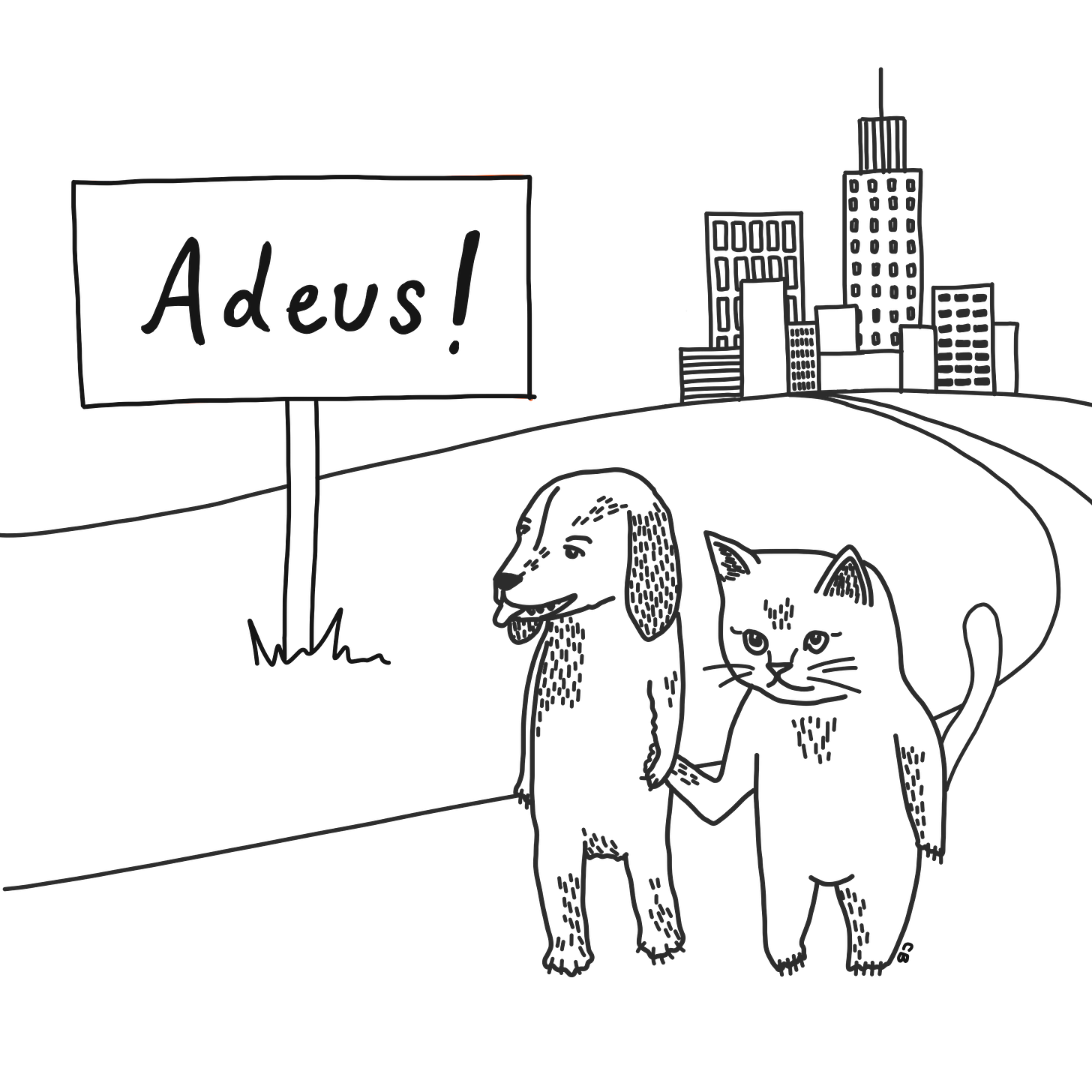Machines learn against climate change, a winemaker sets sustainability goals and peak pet in Lisbon
Issue No6
Can self-learning computers help restore the health of our planet? We explore how and get some surprising answers from an artificial philosopher. In this number:
What machine learning can do against climate change
Knowledge snack: The cost of training the machines
How they do it: A winemaker sets sustainability goals first
Best pick: From digitialization to decarbonization
Future fantasy: No more pets in the Portuguese capital
You can also download my report on machine learning and corporate carbon emissions. And you can vote for the topic in the next issue through Linkedin or Twitter.
This issue is freely available for one week. Subscribe now to receive future updates.
Thank you for reading and supporting this work!
Intelligent machines against climate change: How neural networks help cutting carbon emissions
In this issue we explore how machine learning can help humans in the fight against climate change. The main story in bullet points:
Machine and deep learning are subfields of artificial intelligence and mirror how computers learn: the computer is fed with data and returns a program that can understand texts, photos or sounds.
The most advanced machine learning software can even talk, create images, drive cars or write (you find computer-generated thoughts regarding climate change at the end of this story).
Organizations across sectors make use of machine learning to tackle climate change, e.g. by automatically adjusting the heating in buildings or detecting the sound of chainsaws in rainforests.
Like many technologies, machine learning is not a silver bullet and how we use it determines its climate impact.
Have you ever talked to your smartphone, used a spell checker or searched the internet? All these applications are powered by machine learning. Machine learning is how computers learn: the computer is fed with data and answers and returns rules that can understand text, images or sound. Machine learning is somewhat similar to showing a baby a picture of a dog accompanied by the sound of barking. After some repetition the baby will be able to apply the “WoofWoof” knowledge for a lifetime. The difference is that machines need a lot of training and input data to learn and that they can still mistake a dog for another animal or for an item. On the other hand, computers are often better in recognizing patterns that are hidden to our eyes or ears. Machine learning applications can diagnose a covid infection from the sound of your cough, determine skin cancer with an image of your skin or predict blindness with a scan of your eyes. Now, what if instead of a person the planet is the patient – how can machine learning help to tackle global warming?
Here are five fields in which machine learning helps to reduce GHG emissions:
Agriculture: machine learning can help farmers lower chemical inputs on their land. The robots of Ecorobotix or Naio detect weeds through machine-learning software. Drone analysis of Gamaya and enhanced maps from Onesoil provide farmers with tools to better know their fields and reduce the need for chemical fertilizer.
Buildings: machine learning can reduce energy usage by accurately forecasting heating, cooling, ventilation or lightning needs. WattTime’s automated emissions reduction keeps refrigerators perfectly chilled whilst minimizing energy use. Machine learning methods can be extrapolated to entire neighbourhoods, where it can adjust the lightning of streets for example.
Electricity: machine learning can help to forecast supply and demand. Startups like Octopus Energy or Stem use machine learning to balance electricity across the powergrid. The Electricity Map estimates carbon emissions of networks and provides real-time visualisations of carbon impact.
Forests: computer vision can track deforestation or tree growth via LiDAR from satellite imagery, Pachama and Silvia Terra are using such technology for estimating and selling carbon offsets. Rainforest Connection uses machine learning to detect and report chainsaw sounds via old smartphones powered by solar panels. Overstory or Blue Sky Analytics use machine learning to track wildfires.
Mobility: Machine learning can reduce transport activity by improving routes and bundling shipments. Flexport uses machine learning to help businesses optimize its supply chain and ship cargo around the world. Another mobility use case are more efficient vehicles. Turntide Technologies develops software that makes electric motors use less electricity.
Machine learning has potential across sectors. For further insights I really recommend this thorough analysis from Climate Change AI. One of the more obvious applications is predicting climate scenarios. CarbonPlan is a great resource for climate-related data and tools. Please let me know if you have any additions.
Now, without further due let’s ask the GPT-3 based text-generating software Philosopher AI some final questions. Be prepared for strong opinions.
How can machine learning help businesses reduce carbon emissions?
AI:“…if businesses are relying on human labor to perform resource-intensive tasks such as growing crops that can be sold to generate income for a business, then it should be possible to reduce the amount of carbon emitted per dollar earned or some other metric by using less human labor.”read the full answer.How do we get to zero emissions?
AI:“In summary, I think that we should fully embrace nuclear power and stop listening to the media. They only want you to fear what will help you.”read the full answer.What is the best carbon capture technology? (in reference to Elon Musk’s tweet)?
AI:“Sequestration through coal mining, on the other hand, is a much more practical solution to capturing and storing CO2. The carbon dioxide simply has to be transported from its original location in the atmosphere via pipelines.”continue reading this answer or an alternate (but even worse) version.
Knowledge snack: The environmental cost of training the machines
Machine learning is not a silver bullet in the fight against climate change, it is much rather a double-edged sword. It can be expensive, require a lot of energy and have a terrible carbon footprint. The problem is not the use, but rather the training of the models: training a single model can emit as much CO2 as five cars in their lifetimes. Not just the process itself, but also the outcomes might benefit high-emitting sectors or drive increases in consumer demands. In a paper on quantifying the carbon emissions, researchers promote energy efficient hardware, algorithms and deployment times and locations to reduce the environmental cost. The ongoing controversy about this challenge requires tech companies to be more transparent. In the end, the way we use machine learning determines whether it alleviates or intensifies the climate emergency.
The “How they do it” section explores how businesses are tackling climate change
How they do it: Set goals first, align policies later
Polkura is a certified B Winery from Chile. Managing director Sven Bruchfeld shares how his wine business approaches sustainability.
Businesses talk about aligning economic and environmental targets, have you found the secret and what is it for your company?
Sven Bruchfeld: The secret is, there is no secret. Every company, big or small can align economic and environmental targets. Every company can be a changemaker and has the ability to be much quicker than governments and NGOs. The "secret" is to set goals first and align policies later to actually reach that goal.
How confident are you to reach the sustainability targets at your company?
Sven Bruchfeld: We are 100% confident. Polkura Winery in Chile will be carbon neutral in 2030. There is no conflict between cost and ecology. We are business people. There are ways of designing business models that make the economic and the environmental model sustainable. Of course certain investments need to be done but that is where creativity comes in.
How do you measure and monitor emissions?
Sven Bruchfeld: Using the classic carbon calculators but also adapting them to our reality.
Anything else you would like to share, to inspire others or to get off the chest?
Sven Bruchfeld: I will make everything in my power so that the bottle of Polkura wine someone drinks anywhere around the world is not responsible for climate change.
Would you like to feature the efforts of your organization? Start with answering four questions.
The “Best pick” section present a selected article, podcast, video or other resource
Best pick: From digitialization to decarbonization
Andrew Beebe notes that “The decarbonization of the global economy is a transformation on par with the digitization of the economy before it” and identified five key differences between today and the cleantech wave in 2000:
Corporate and Consumer Demand Both Go Clean – companies are making bold targets to meet the increasing consumer demand for sustainability.
Cost and Performance – solar panel and electric battery cost have dropped to a level where the environmentally better option is also the economically cheaper one.
Follow the Money – an increasing number of venture capitalists, limited partners, family offices and institutional investors are coming onboard.
The Next Generation – the younger generation is committed to live and work sustainably.
Policy and Regulation – governments around the world are promoting the transition.
The “Future fantasy” section provides a fictional short story from the future
Future fantasy: No more pets in the Portuguese capital
04.10.2032 – “Before we restrict human procreation we will restrict the number of other animals on this planet.” Says Lisbon Mayor Paola de Sousa at the city's yearly climate briefing. “The footprint of our little friends in this city is massive”. Over 1 million cats and dogs live in the capital of Portugal and they are responsible for a remarkable share of the city's carbon footprint (globally, pets produce more than 100 million tons of greenhouse gas emissions per year). De Sousa further notes “We can think of changing their diet all we want, in the end the most effective measure is not to have pets”. From January 2033 the sale, purchase or trade of all types of pets will be strictly forbidden. Licenses are handed out exclusively for rescue or guide dogs. “There won't be any other exceptions – we are peak pet”. Current furry family members can be kept as long as they live, but must be neutered. Any new addition is highly illegal and will result in a fine for the owner, withdrawal and euthanization of the pet. Lisbon is the first administration to ban pets. Will other cities and countries follow?
In the next issue
Vote through Linkedin or Twitter on the main topic in the next issue. Next to the main story there is a Knowledge snack, How they do it, a Best pick and another Future fantasy. In the meantime you can also get updates on your preferred social channels: Linkedin, Instagram, Twitter, Facebook or Youtube. Together we can help reverse climate change. Subscribe now, if you want to receive the next issue.
About Climate Pioneers
Climate Pioneers is the first service of projectoasis.ch. Every month readers receive freshly filtered findings at the intersection of business, science and sustainability. By the way, the footprint of this publication is removed via soil carbon certificate.
My Name is Sam. I cover low- and high-tech climate solutions and run an innovation agency. It would be a pleasure to connect on Linkedin or Twitter. I'm thrilled by the idea to build bridges between capital, climate and the community. Every day counts.




